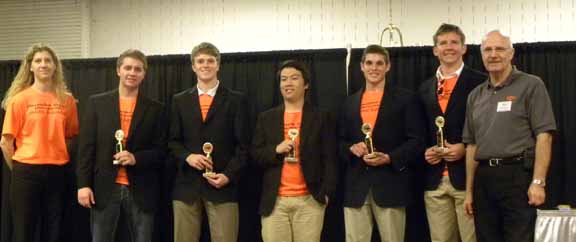OSU team takes third at international competition
Tuesday, October 30, 2012
The OSU team earned third place honors against 35 competitors in the international Chem-E-Car competition at Cornell University in Pittsburgh over the weekend. Known as “The B Team” the five OSU seniors used a car that ran on a baking soda and vinegar mix to take the bronze. The cars range in size from shoeboxes to fire hydrants and run on various alternative fuels.
Congratulations to OSU team members, including Nicholas Cain from Tuttle; Osbert Luong, Deer Creek; Mat Miskelly, Harrah; Nate Nahmias, Tulsa and Cason, Sanders, Hollis. Their title “The B Team” reflects the fact that they are “all business.”
This year’s winner from Cornell ran on a zinc air battery. The second place award went to the University of Puerto Rico, Mayaguez, for a car powered by a hydrogen peroxide reaction. The competition, held in conjunction with AIChE’s Annual Meeting, highlights the important role chemical engineers have played in the creation of today’s existing fuels and the role they will continue to play in developing alternative fuels in the future. The ultimate goal of the competition is to teach students – our future scientists -- to think creatively about alternative fuel technology.
“The Chem-E-Car competition is a great way for our future engineers to apply chemical engineering principles in a creative way, in a team setting – much as they will in the ‘real world’ once they graduate,” said David Rosenthal, AIChE president. “These students show real creativity and promise, and some day, these technologies could be used commercially.”
The competition involves the cars carrying a load. The student engineers do not know the size and weight of the load their car has to carry or the distance it must travel until the competition begins. The students then scramble to calculate how to get their car as close to the distance goal as possible. This year, the cars had to carry 300 millileters of water for 21 meters, and Cornell University was dead-on at the finish line, managing to carry the load for 21 meters exactly and taking the $2,000 first place prize.

